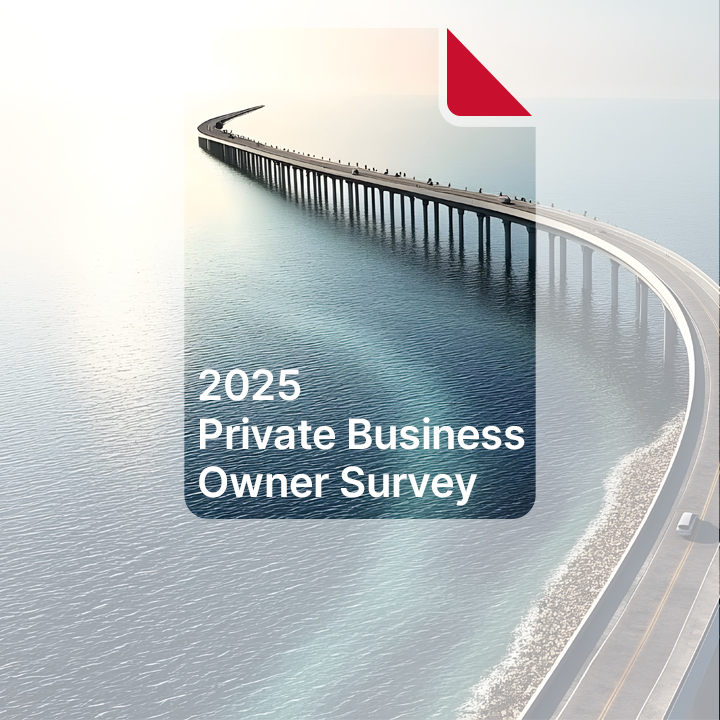In our third annual Private Business Owner Survey, nearly 62% of private business owners said they planned to transition ownership to the next generation when asked about their long-term strategy. Despite this intention, engaging and preparing the next generation in succession planning can be daunting for all parties involved – and indeed, 46% of respondents cited family dynamics as the biggest challenge to the process. The current generation may think, “I am not ready to retire. What will I do without this business?” Meanwhile, the next generation may get frustrated with the lack of planning and think, “We’re moving too slowly. The current generation is too controlling, and I feel stuck. When will I be able to go anywhere in this company?”
Of course, worries abound among both parties about where to start, what to do, and how to know it will work. While the questions are plentiful, and the anxiety is real, it’s important for family business owners to know that this is a standard evolution for any firm. At BBH, we’ve worked with thousands of family businesses, and this is the most normal and common event that we see. Yet individuals still hold off on transition planning, with our results finding that 46% were still in the process of putting together their plan, and nearly 30% saying they had no plan at all. Here, we share several components to help the process run smoothly.
Biggest challenges to the succession planning process
Establish a clear priority of ownership over management as everyone’s
Current generation perspective: How do we choose who will be the next CEO among our family members? I’m worried no one is prepared!
Next generation perspective: I want to be the next CEO, but so does my cousin. How can I make sure I am the chosen one?
When thinking about engaging the next generation in succession planning, there’s an inclination for family businesses to focus on management succession, or who is going to run the company. However, the first area of focus should be ownership succession. Executives are replaceable; owners of a family business are not.
In the event of death, the business passes down to family members, outlined in estate planning documents – and those individuals will assume ownership whether prepared or not. As such, as a first priority, the current and next generation of owners need to think about how they are going to own the business together and determine what is in their collective best interest and what they do next as owners. For example, when thinking about ownership first, the right answer to questions about who in the family is going to run the business may be that an outsider will be named CEO if no family members are qualified.
Give the next generation a voice and, when they are ready, a vote!
Families might consider establishing owner and family councils that include the next generation so that from a young age they understand the business and the key strategic decisions that are made. This governance involvement also helps them understand that these structures give owners who aren’t in management or leadership a voice. Remember that there is a difference between a vote and a voice, and as owners or successor owners of the business, next generation members can still play a significant role and provide input in terms of major governance issues at the company.
Engaging the next generation in these governance vehicles early also helps with issues where it appears as though the older generation is still completely in control – and unwilling to release any power. When multiple generations are involved in meetings and decision-making together, any perceptions that one generation has full control over another begin to disappear.
Frame decisions as best outcomes for owners
Current generation perspective: I want my first-born to be CEO, but I’m not sure they’re equipped to handle it. How do I make this decision?
Next generation perspective: All of my siblings are fighting over who gets to be the next leader, and it’s unclear what the best decision is for the company.
Once everyone has adopted the mindset of prioritizing ownership over management, it is important to have planning conversations and ultimately make decisions about how to achieve the best outcomes as owners. When asked about succession planning challenges, one survey respondent said that, “Specific to ownership succession, the biggest challenge is the education of the shareholders on the alternatives.” For example, when examining how important it is that management, board members, and operating roles are filled by family members, think through the implicit trade-offs. A person who is a family member may have a greater commitment to the business, but do they have greater competence?
In certain situations, a family may be insistent on hiring a family member as successor. In other cases, even where family members are involved, the next generation may choose to participate in the business in another capacity – as board members, for example – and hire an outsider to take over management. Most importantly, the family should know that this may change over time, as one respondent said, “We prefer succession from within. Historically, it has always been family-led. Going forward, it is likely that we will have periods of time when we have nonfamily members leading the business.” No matter the situation, this is not an easy decision to make, so it is key to approach it in terms of what will deliver the best outcome for owners, particularly when there are multiple family members who have an interest in active employment.
Get specific about roles and requirements
Current generation perspective: How do we choose the next CEO among all of the next generation members? Should we just go with the oldest member of the generation?
Next generation perspective: I want to be CEO, but I have no clue what I need to go through to get there. Is it a game of favorites, or is there actual criteria I need to meet?
In order to ensure that everyone is on the same page about the jobs that need to be done and the requirements involved, it’s important that family business owners formalize and communicate the objective process through which they will choose individuals to fill vacant executive roles, as well as the skills and requirements that candidates must meet. Ideally, a retiring CEO or other executive has already gone through the process of outlining their role and forming a job description for successors, and the family can leverage this work. Exceptions should generally not be made, and if they are, the rationale for the exception should be made clear to all. Mapping out a process together that clearly states how you will choose successors, and that involves input from several people, helps foster buy-in among all generations.
It is important to make clear that the evaluation process is a legitimate one that everyone – family and nonfamily – must go through. For example, next generation owners who are interested in working in the business should be evaluated by the leadership team (family and nonfamily) to ensure an objective evaluation. For leadership roles, it is often advisable to put the next generation through an interview process with an outside recruiter just as you would in a search for an outsider. Having a clear, clean process that includes input from all generations and outlines these elements is crucial for minimizing any assumptions of favoritism and emotional responses when the successor is named, which are almost inevitable in a family business.
Develop the next generation with intention
Current generation perspective: My child does not seem ready to own this company that I grew from the ground up. I’m worried about how to prepare them so that they don’t ruin it.
Next generation perspective: I grew up in this company. It’s in my blood. I’ll be a fine owner.
Successor readiness is a common concern. One survey respondent said that their “potential successor has not proved abilities to be able to operate the company.” To the extent that family business owners have an interest in having family members fill critical company positions, they must decide what needs to be done in order to ensure the next generation is prepared to fill those roles and meet their requirements. This is an exercise in working together to determine how the current generation can push the next generation along so that they are eventually fully prepared to assume leadership.
Owners may know who they want to succeed current executives based on the process and requirements put in place, but how can they assess whether individuals are ready? Families who have gone through the earlier steps of understanding what’s required of each role may have a better initial understanding of whether someone is prepared, and being armed with a job description or objective criteria can help alleviate some of the emotional impact around this decision.
At BBH, we also have a succession readiness matrix tool that we share with clients. Completing this exercise together helps families have honest conversations about the readiness of both parties – the founder and the successor – and outlines next steps should one not be ready.
FOUNDER NOT READY; SUCCESSOR READY
Steps to move to the right:
- Delegate distinct projects or divisions to emerging leader(s)
- Arrange founder peer group/mentor for guidance
- Design life transition plan
- Consider sabbatical of 1-3-6 months for founder
- Enlist board in helping facilitate this transition
- Identify agents of change to increase advocacy and push the process forward
FOUNDER READY; SUCCESSOR READY
Steps to succeed:
- Design timeline, governance structures, and processes
- Successor to work with owner/sibling group on roles and responsibilities
- Develop clear delineation of roles and responsibilities between founder and successor
- Agree on benchmarks of success for the transition and for each person
- Develop transition communication plan
- Founder to begin post-transition life plans
FOUNDER READY; SUCCESSOR NOT READY
Steps to move up:
- Create mentor team for successor
- Utilize external competency building opportunities as needed to augment internal work
- Hire/promote nonfamily executive talent
FOUNDER NOT READY; SUCCESSOR NOT READY
Steps to move up and to the right:
- Develop governance and succession plan including professional development for successor
- Successor, if a child, to strengthen sibling trust and communication
- Founder and successor to work on communication training
- Board to ensure that successor has real reasonability, authority, and accountability (when not bolstered by founder)
Pivot the current generation’s role from decision-maker to mentor
Current generation perspective: I want to support the next generation as owners, but they approach things differently. I’m stuck on how to help.
Next generation perspective: The older generation wants us to do everything exactly the way they did it – they’re stuck in history! How can I convince them I’m ready?
When the next generation is ready to succeed the current generation as owners and operators, success requires the current generation to accept the differences in the next generation’s approach and trust them to run the business in a way that delivers the best results for owners. Here, the goal is working together, as opposed to making the next generation operate exactly as the current generation did. Instead, the current generation must identify where they can best add value and support for the next generation as they shape the company’s future. The current generation must accept that their new relationship with the business and how it functions is in an advisory capacity, while the next generation has finally stepped in as decision-makers.
Conclusion
While all family businesses are one day faced with the task of collaborating across generations on succession, the process is highly personal for each company. It involves family dynamics, which can be complicated, and there is no one-size-fits-all solution. However, know that there is a way to get through the experience, and often, getting assistance from outsiders – whether informal advice from other business owners or formal guidance from third-party advisors – can help owners in addressing many of the difficult questions or challenges that come up.
At BBH, we leverage our network of business owners to help our clients who are going through the succession planning process and also provide insight gleaned from our own experience as a private partnership that has gone through 13 generational transitions. We would be happy to help your family as well.
Contact Us
Brown Brothers Harriman & Co. (“BBH”) may be used to reference the company as a whole and/or its various subsidiaries generally. This material and any products or services may be issued or provided in multiple jurisdictions by duly authorized and regulated subsidiaries. This material is for general information and reference purposes only and does not constitute legal, tax or investment advice and is not intended as an offer to sell, or a solicitation to buy securities, services or investment products. Any reference to tax matters is not intended to be used, and may not be used, for purposes of avoiding penalties under the U.S. Internal Revenue Code, or other applicable tax regimes, or for promotion, marketing or recommendation to third parties. All information has been obtained from sources believed to be reliable, but accuracy is not guaranteed, and reliance should not be placed on the information presented. This material may not be reproduced, copied or transmitted, or any of the content disclosed to third parties, without the permission of BBH. All trademarks and service marks included are the property of BBH or their respective owners. © Brown Brothers Harriman & Co. 2025. All rights reserved. PB-09032-2025-10-29









